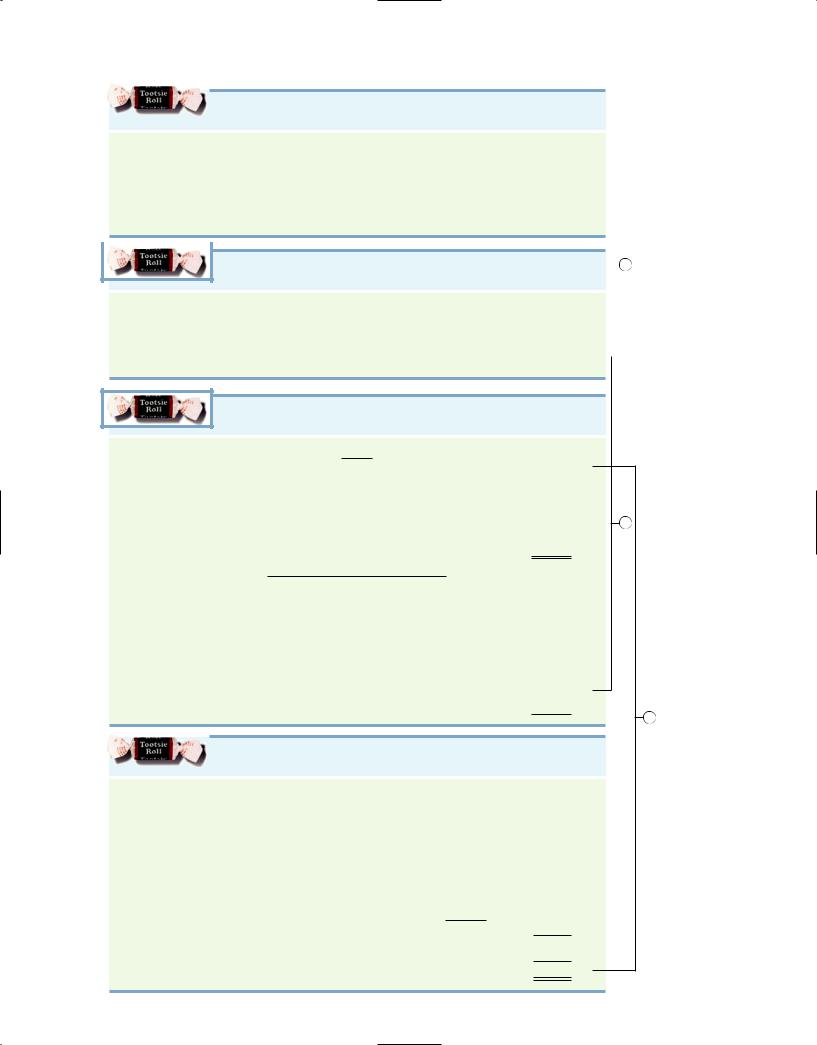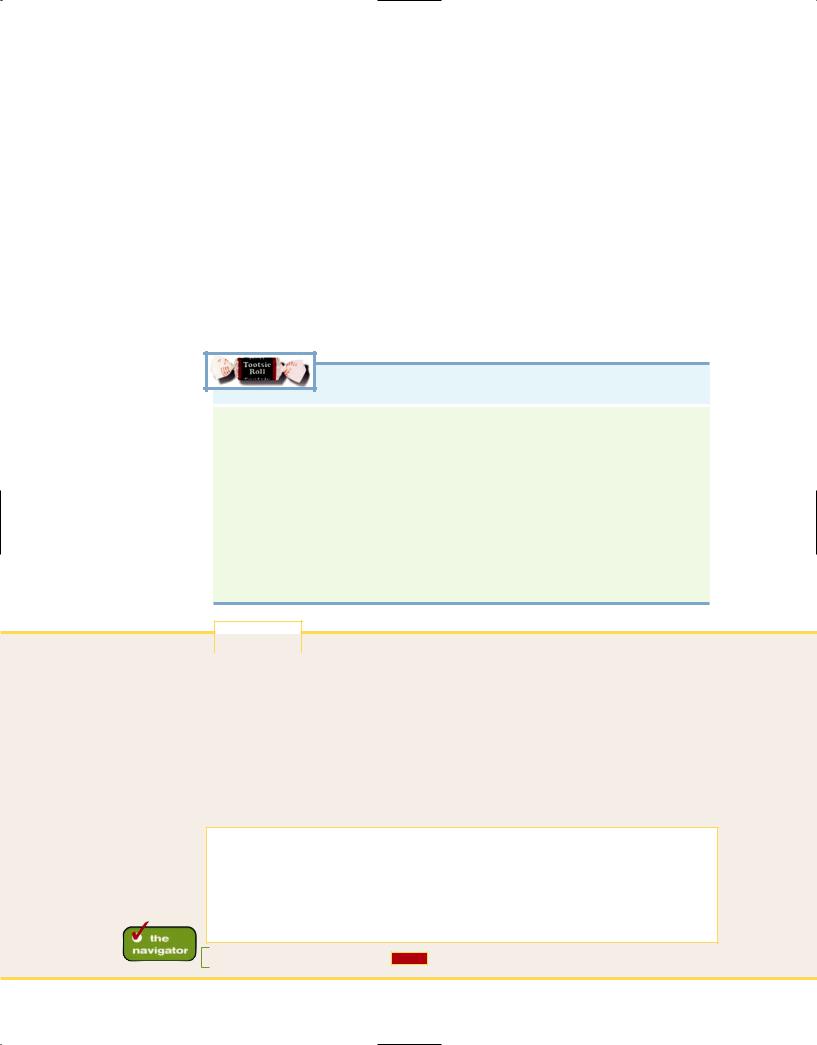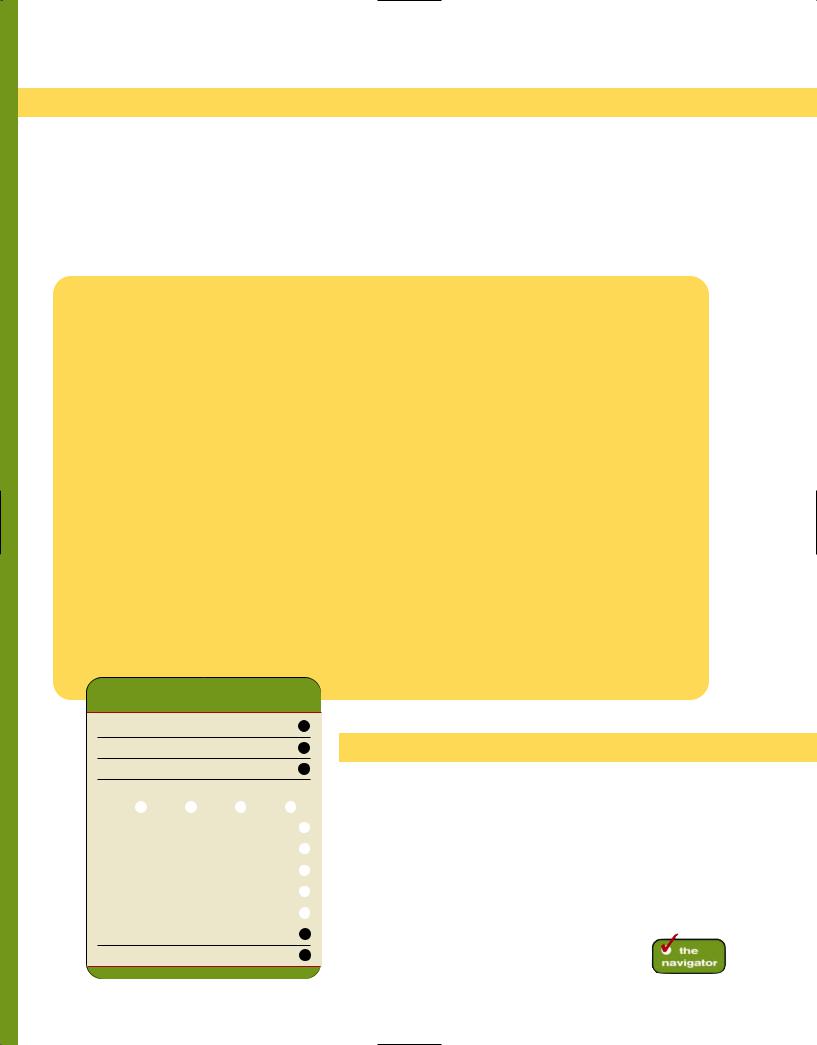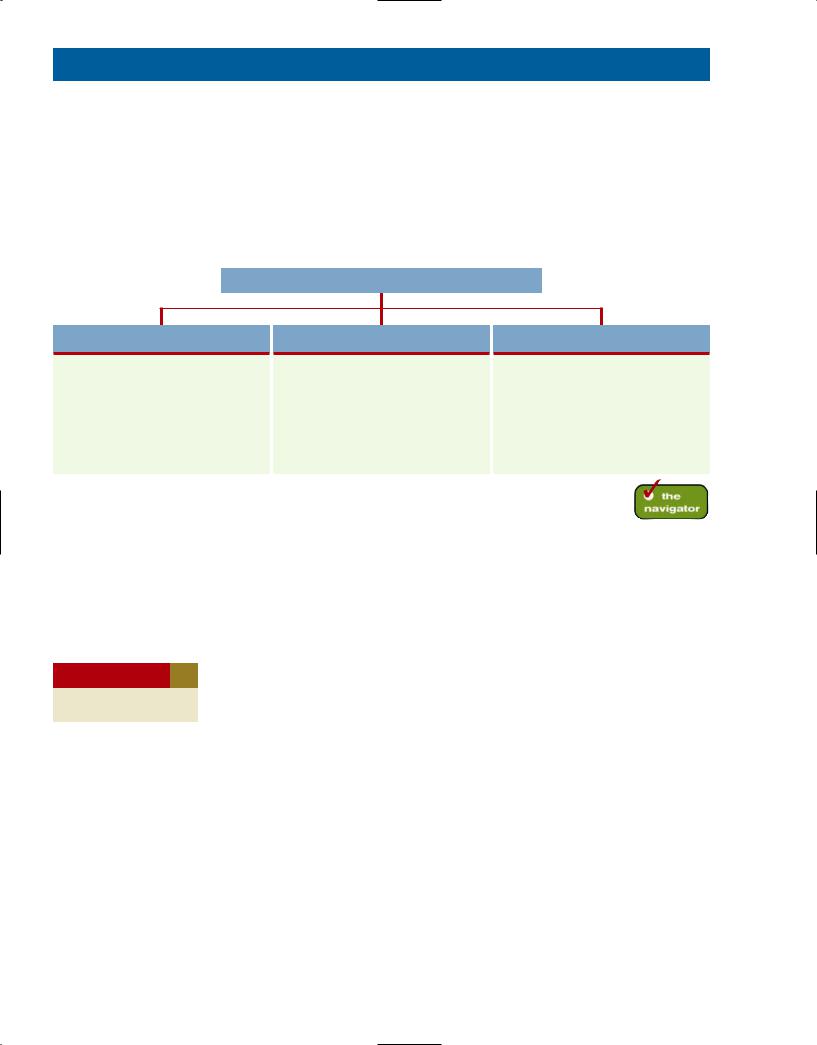
Финансовый учет. Ридер
.pdf
180 |
|
|
|
|
TOOTSIE ROLL INDUSTRIES, INC. |
|
|
|
|
|
|
|
Income Statement |
|
|
|
For the Year Ended December 31, 2009 (in thousands) |
||
Revenues |
|
|
|
Expenses |
|
|
|
Cost of goods sold |
$319,497 |
||
Selling, marketing, and administrative expense and other |
115,655 |
||
Income tax expense |
10,704 |
||
Total expenses |
|
|
|
Net income |
|
|
|
|
TOOTSIE ROLL INDUSTRIES, INC. |
|
|
|
|
|
|
|
Retained Earnings Statement |
|
|
For the Year Ended December 31, 2009 (in thousands)
Retained earnings, January 1, 2009
Add: Net income
Less: Dividends and other (net)
Retained earnings, December 31, 2009
TOOTSIE ROLL INDUSTRIES, INC.
Balance Sheet
December 31, 2009 (in thousands)
Assets
Cash
Investments
Accounts receivable
Inventories
Prepaid expenses
Property, plant and equipment, net
Other assets
Total assets
Liabilities and Stockholders’ Equity
Liabilities |
|
|
|
|
|
Accounts payable |
$ 9,140 |
||||
Dividends payable |
4,458 |
||||
Accrued liabilities |
42,468 |
||||
Deferred income taxes payable |
44,582 |
||||
Bonds payable |
7,500 |
||||
Employee benefits payable and other |
77,614 |
||||
Stockholders’ equity |
|
|
|
|
|
Common stock |
506,557 |
||||
Retained earnings |
145,928 |
||||
Total liabilities and stockholders’ equity |
|
|
|
|
|
|
|
|
|
||
|
TOOTSIE ROLL INDUSTRIES, INC. |
|
|
|
|
|
|
|
|
|
|
|
Statement of Cash Flows |
|
|
|
|
|
For the Year Ended December 31, 2009 (in thousands) |
||||
|
|||||
Cash flows from operating activities |
|
|
|
|
|
Cash receipts from operating activities |
$491,344 |
||||
Cash payments for operating activities |
(416,063) |
||||
Net cash provided by operating activities |
|
|
|
|
|
Cash flows from investing activities |
|
|
|
|
|
Capital expenditures and acquisitions |
(20,831) |
||||
Net purchases/sales of investment securities and other |
6,180 |
||||
Net cash used by investing activities |
|
|
|
|
|
|
|
|
|
||
Cash flows from financing activities |
|
|
|
|
|
Repurchase of common stock |
(20,723) |
||||
Dividends paid in cash |
(17,825) |
||||
Net cash used by financing activities
Net increase (decrease) in cash
Cash at beginning of year
Cash at end of year
Communicating with Users 17
Illustration 1-9 Tootsie Roll Industries, Inc.’s financial statements
$499,331
|
|
|
|
|
|
Helpful Hint Note that final |
|
|
|
|
|
|
|
sums are double-underlined, |
|
445,856 |
|
|
|
|
|
and negative amounts (in the |
|
|
|
|
|
|
statement of cash flows) are |
||
|
|
|
|
|
|
||
$ 53,475 |
|
|
|
||||
|
→ |
||||||
|
|
|
|
presented in parentheses. |
|||
|
|
|
|
|
|
||
$142,872 |
|
|
|
|
|
1 |
|
|
|
|
|
|
|||
|
|
|
|
|
Helpful Hint The arrows in this |
||
53,475 |
|
|
|
|
|||
→ |
|||||||
|
|
|
|
illustration show interrelationships |
|||
196,347 |
|
|
|||||
|
|
|
|
||||
50,419 |
|
|
|
|
of the four financial statements. |
||
$145,928 |
|
→ |
|
|
|||
|
|
|
|
||||
|
|
|
|
|
|
||
|
|
|
|
|
|
|
|
$ 90,990 |
→ |
|
|
8,663 |
|
45,909 |
|
56,387 |
|
8,562 |
2 |
220,721 |
|
407,015 |
|
$838,247 |
|
$185,762
652,485 |
→ |
|
$838,247
3
$ 75,281 |
|
(14,651) |
|
(38,548) |
|
22,082 |
|
68,908 |
|
$ 90,990 |
→ |
|

181
18 chapter 1 Introduction to Financial Statements
before you go on...
FINANCIAL
STATEMENTS
Action Plan
•Report the revenues and expenses for a period of time in an income statement.
•Show the amounts and causes (net income and dividends) of changes in retained earnings during the period in the retained earnings statement.
•Present the assets and claims to those assets at a specific point in time in the balance sheet.
 CSU Corporation began operations on January 1, 2012. The following information is available for CSU Corporation on December 31, 2012:
CSU Corporation began operations on January 1, 2012. The following information is available for CSU Corporation on December 31, 2012:
Accounts receivable |
1,800 |
Retained earnings |
? |
Supplies expense |
200 |
Accounts payable |
2,000 |
Equipment |
16,000 |
Cash |
1,400 |
Building rental expense |
9,000 |
Insurance expense |
1,000 |
Dividends |
600 |
Notes payable |
5,000 |
Service revenue |
17,000 |
|
|
Common stock |
10,000 |
Supplies |
4,000 |
|
|
Prepare an income statement, a retained earnings statement, and a balance sheet.
Solution
CSU CORPORATION
Income Statement
For the Year Ended December 31, 2012
Revenues |
|
|
|
|
|
Service revenue |
$17,000 |
||||
Expenses |
|
|
|
|
|
Rent expense |
$9,000 |
|
|
||
Insurance expense |
1,000 |
|
|
||
Supplies expense |
|
200 |
|
|
|
Total expenses |
|
|
10,200 |
||
Net income |
$ 6,800 |
||||
|
|
|
|
|
|
|
|
|
|
|
|
CSU CORPORATION
Retained Earnings Statement
For the Year Ended December 31, 2012
Retained earnings, January 1 |
$ |
0 |
||
Add: Net income |
|
|
6,800 |
|
|
|
|
6,800 |
|
Less: Dividends |
|
|
600 |
|
|
|
|
|
|
Retained earnings, December 31 |
$6,200 |
|
||
|
|
|
|
|
|
|
|
|
|
CSU CORPORATION |
|
|
|
|
|
|
|
Balance Sheet |
|
|
|
|
|
|
|
December 31, 2012 |
|
|
|
|
|
|
|
|
|
|
|
|
|
|
|
Assets |
|
|
|
|
|
|
|
Cash |
|
|
$ |
1,400 |
|
||
Accounts receivable |
|
|
|
|
|
1,800 |
|
Supplies |
|
|
|
|
|
4,000 |
|
Equipment |
|
|
|
|
|
16,000 |
|
Total assets |
|
|
$23,200 |
|
|||
Liabilities and Stockholders’ Equity |
|
|
|
||||
Liabilities |
|
|
|
|
|
|
|
Notes payable |
$ |
5,000 |
|
|
|
||
Accounts payable |
|
|
2,000 |
|
|
|
|
Total liabilities |
|
|
|
$ |
7,000 |
|
|
Stockholders’ equity |
|
|
|
|
|
|
|
Common stock |
|
|
10,000 |
|
|
|
|
Retained earnings |
|
|
6,200 |
|
|
|
|
Total stockholders’ equity |
|
|
|
|
|
16,200 |
|
Total liabilities and stockholders’ equity |
|
|
$23,200 |
|
|||
|
|
|
|
|
|
|
|
Related exercise material: BE1-5, BE1-6, BE1-7, BE1-8, BE1-9, BE1-10, Do it! 1-3, E1-4, E1-5,
E1-6, E1-7, E1-8, E1-9, E1-10, E1-11, and E1-14.

182
Communicating with Users 19
OTHER ELEMENTS OF AN ANNUAL REPORT
U.S. companies that are publicly traded must provide shareholders with an annual report. The annual report always includes the financial statements introduced in this chapter. The annual report also includes other important information such as a management discussion and analysis section, notes to the financial statements, and an independent auditor’s report. No analysis of a company’s financial situation and prospects is complete without a review of these items.
Management Discussion and Analysis
The management discussion and analysis (MD&A) section covers various financial aspects of a company, including its ability to pay near-term obligations, its ability to fund operations and expansion, and its results of operations. Management must highlight favorable or unfavorable trends and identify significant events and uncertainties that affect these three factors. This discussion obviously involves a number of subjective estimates and opinions. A brief excerpt from the MD&A section of Tootsie Roll’s annual report is presented in Illustration 1-10.
study objective 6
Describe the components that supplement the financial statements in an annual report.
|
|
|
Illustration 1-10 Tootsie |
|
|
TOOTSIE ROLL INDUSTRIES, INC. |
|
|
|
Roll’s management |
|
|
|
Management’s Discussion and Analysis of |
discussion and analysis |
|
|
||
|
|
Financial Condition and Results of Operations |
|
|
|
|
|
The Company has a relatively straightforward financial structure and has historically maintained a conservative financial position. Except for an immaterial amount of operating leases, the Company has no special financing arrangements or “off-balance sheet” special purpose entities. Cash flows from operations plus maturities of shortterm investments are expected to be adequate to meet the Company’s overall financing needs, including capital expenditures, in 2010.
Notes to the Financial Statements
Explanatory notes and supporting schedules accompany every set of financial statements and are an integral part of the statements. The notes to the financial statements clarify the financial statements, and provide additional detail. Information in the notes does not have to be quantifiable (numeric). Examples of notes are descriptions of the significant accounting policies and methods used in preparing the statements, explanations of uncertainties and contingencies, and various statistics and details too voluminous to be included in the statements. The notes are essential to understanding a company’s operating performance and financial position.
Illustration 1-11 is an excerpt from the notes to Tootsie Roll’s financial statements. It describes the methods that Tootsie Roll uses to account for revenues.
TOOTSIE ROLL INDUSTRIES, INC.
Notes to Financial Statements
Revenue recognition
Revenue, net of applicable provisions for discounts, returns, allowances, and certain advertising and promotional costs, is recognized when products are delivered to customers based on a customer purchase order, and collectibility is reasonably assured.
Illustration 1-11 Notes to Tootsie Roll’s financial statements
Auditor’s Report
An auditor’s report is prepared by an independent outside auditor. It states the auditor’s opinion as to the fairness of the presentation of the financial position and results of operations and their conformance with generally accepted accounting standards.

183
20 chapter 1 Introduction to Financial Statements
Illustration 1-12 Excerpt from auditor’s report on Tootsie Roll’s financial statements
before you go on...
An auditor is an accounting professional who conducts an independent examination of a company’s financial statements. Only accountants who meet certain criteria and thereby attain the designation Certified Public Accountant (CPA) may perform audits. If the auditor is satisfied that the financial statements provide a fair representation of the company’s financial position and results of operations in accordance with generally accepted accounting principles, then the auditor expresses an unqualified opinion. If the auditor expresses anything other than an unqualified opinion, then readers should only use the financial statements with caution. That is, without an unqualified opinion, we cannot have complete confidence that the financial statements give an accurate picture of the company’s financial health. For example, in April 2009 Blockbuster, Inc.’s auditor stated that its financial situation raised “substantial doubt about the Company’s ability to continue as a going concern.”
Illustration 1-12 is an excerpt from the auditor’s report from Tootsie Roll’s 2009 annual report. Tootsie Roll received an unqualified opinion from its auditor, PricewaterhouseCoopers.
TOOTSIE ROLL INDUSTRIES, INC.
Excerpt from Auditor’s Report
To the Board of Directors and Shareholders of Tootsie Roll Industries, Inc.
In our opinion, the accompanying consolidated statements of financial position and the related consolidated statements of earnings, comprehensive earnings and retained earnings, and of cash flows present fairly, in all material respects, the financial position of Tootsie Roll Industries, Inc. and its subsidiaries at December 31, 2009 and December 31, 2008, and the results of their operations and their cash flows for each of the three years in the period ended December 31, 2009 in conformity with accounting principles generally accepted in the United States of America. Also in our opinion, the Company maintained, in all material respects, effective internal control over financial reporting as of December 31, 2009, based on criteria established in Internal Control— Integrated Framework issued by the Committee of Sponsoring Organizations of the Treadway Commission (COSO).
COMPONENTS OF ANNUAL REPORTS
Action Plan
•Realize that financial statements provide information about a company’s performance and financial position.
•Be familiar with the other elements of the annual report in order to gain a fuller understanding of a company.
 State whether each of the following items is most closely associated with the management discussion and analysis (MD&A), the notes to the financial statements, or the auditor’s report.
State whether each of the following items is most closely associated with the management discussion and analysis (MD&A), the notes to the financial statements, or the auditor’s report.
1.Descriptions of significant accounting policies
2.Unqualified opinion
3.Explanations of uncertainties and contingencies
4.Description of ability to fund operations and expansion
5.Description of results of operations
6.Certified Public Accountant (CPA)
Solution
1.Descriptions of significant accounting policies: Notes.
2.Unqualified opinion: Auditor’s report.
3.Explanations of uncertainties and contingencies: Notes.
4.Description of ability to fund operations and expansion: MD&A.
5.Description of results of operations: MD&A.
6.Certified Public Accountant (CPA): Auditor’s report.
Related exercise material: BE1-11, Do it! 1-4, and E1-17.

184
chapter 2
A FURTHER LOOK AT FINANCIAL STATEMENTS
● the navigator
● Scan Study Objectives
● Read Feature Story
● Scan Preview
● Read Text and Answer |
|
Do it! |
|
|
|
|
||||||||
p. 52 |
|
p. 53 |
|
|
|
p. 62 |
|
|
|
p. 68 |
|
|
|
|
|
|
|
|
|
|
|
||||||||
|
|
|
|
|
|
|
|
|
|
|
|
|
|
|
● Work Using the Decision Toolkit |
|
|
|
|
||||||||||
|
|
|
|
|||||||||||
|
|
|
|
|
|
|
|
|
|
|
|
|
||
● Review Summary of Study Objectives |
|
|
||||||||||||
|
|
|||||||||||||
|
|
|
|
|
|
|
|
|
|
|
|
|
|
|
● Work Comprehensive |
|
|
|
|
|
|
p. 72 |
|
|
|||||
|
Do it! |
|
|
|
||||||||||
|
|
|
|
|
|
|
|
|
|
|
|
|
|
|
● Answer Self-Test Questions |
|
|
|
|
||||||||||
|
|
|
|
|||||||||||
|
|
|
|
|
|
|
|
|
|
|
|
|
|
|
● Complete Assignments |
|
|
|
|
|
|
|
|
|
|||||
|
|
|
|
|
|
|
|
|
||||||
|
|
|
|
|
|
|
|
|
|
|
|
|
|
|
● Go to WileyPLUS for practice and tutorials
●  Read A Look at I FRS p. 96
Read A Look at I FRS p. 96
study objectives
After studying this chapter, you should be able to:
1Identify the sections of a classified balance sheet.
2Identify and compute ratios for analyzing a company’s profitability.
3Explain the relationship between a retained earnings statement and a statement of stockholders’ equity.
4Identify and compute ratios for analyzing a company’s liquidity and solvency using a balance sheet.
5Use the statement of cash flows to evaluate solvency.
6Explain the meaning of generally accepted accounting principles.
7Discuss financial reporting concepts.
INSIDE CHAPTER 2…
46

185
Few people could have predicted how dramatically the Internet would change the investment world. One of the most interesting results is how it has changed the way ordinary people invest their savings. More and more people are striking out on their own, making their own investment decisions.
Two early pioneers in providing investment information to the masses were Tom and
David Gardner, brothers who created an online investor bulletin board called The Motley Fool. The name comes from Shakespeare’s As You Like It. The fool
in Shakespeare’s plays was the only one who could speak unpleasant truths to kings and queens without being killed. Tom and David view themselves as 21stcentury “fools,” revealing the “truths” of Wall Street to the small investor, who they feel has been taken advantage of by Wall Street insiders. Their online bulletin board enables investors to exchange information and insights about companies.
Critics of these bulletin boards contend that they are high-tech rumor mills. They suggest that the fervor created by bulletin board chatter causes investors to bid up stock prices to unreasonable levels. Because bulletin board participants typically use aliases, there is little to stop people from putting misinformation on the board to influence a stock’s price. For example, the stock of PairGain Technologies jumped 32 percent in a single day as a result of a bogus takeover rumor on an investment bulletin board. Some observers are concerned that small investors—ironically, the very people the Gardner brothers are trying to help—will be hurt the most by misinformation and intentional scams.
feature story
To show how these bulletin boards work, suppose that in a re-
cent year you had $10,000 to invest. You were considering Best Buy Company, the largest seller of electronics equipment in the United States. You scanned the Internet investment bulletin boards and found messages posted by two different investors. Here are
excerpts from actual postings during the same year:
TMPVenus: “Where are the prospects for positive movement for this company? Poor margins, poor management,
astronomical P/E!”
broachman: “I believe that this is a LONG TERM winner, and presently at a good price.”
One says sell, and one says buy. Whom should you believe? If you had taken “broachman’s” advice and purchased the stock, the $10,000 you invested would have been worth over $300,000 five years later. Best Buy was one of America’s best-performing stocks during that period of time.
Deciding what information to rely on is becoming increasingly complex. For example, shortly before its share price completely collapsed, nearly every professional analyst who followed Enron was recommending its stock as a “buy.”
Rather than getting swept away by rumors, investors must sort out the good information from the bad. One thing is certain—as information services such as The Motley Fool increase in number, gathering information will become even easier. Evaluating it will be the harder task.
INSIDE CHAPTER 2 . . .
●Can a Company Be Too Liquid? (p. 60)
●When Debt Is Good (p. 61)
●The Korean Discount (p. 64)
●What Do These Companies Have in Common? (p. 65)
47

186
preview of chapter 2
If you are thinking of purchasing Best Buy stock, or any stock, how can you decide what the stock is worth? If you manage J. Crew’s credit department, how should you determine whether to extend credit to a new customer? If you are a financial executive of IBM, how do you decide whether your company is generating adequate cash to expand operations without borrowing? Your decision in each of these situations will be influenced by a variety of considerations. One of them should be your careful analysis of a company’s financial statements. The reason: Financial statements offer relevant and reliable information, which will help you in your decision making.
In this chapter, we take a closer look at the balance sheet and introduce some useful ways for evaluating the information provided by the financial statements. We also examine the financial reporting concepts underlying the financial statements.
A Further Look At Financial Statements
The Classified Balance Sheet
•Current assets
•Long-term investments
•Property, plant, and equipment
•Intangible assets
•Current liabilities
•Long-term liabilities
•Stockholders’ equity
Using the Financial Statements
•Ratio analysis
•Using the income statement
•Using the statement of stockholders’ equity
•Using a classified balance sheet
•Using the statement of cash flows
Financial Reporting Concepts
•The standard-setting environment
•Qualities of useful information
•Assumptions
•Principles
•Constraints
study objective 1
Identify the sections of a classified balance sheet.
In Chapter 1, we introduced the four financial statements. In this section, we review the financial statements and present tools that are useful for evaluating them. We begin by introducing the classified balance sheet.
The Classified Balance Sheet
In Chapter 1, you learned that a balance sheet presents a snapshot of a company’s financial position at a point in time. The balance sheet in Chapter 1 listed individual asset, liability and stockholders’ equity items in no particular order. To improve users’ understanding of a company’s financial position, companies often use a classified balance sheet. A classified balance sheet groups together similar assets and similar liabilities, using a number of standard classifications and sections. This is useful because items within a group have similar economic characteristics. A classified balance sheet generally contains the standard classifications listed in Illustration 2-1.
Illustration 2-1 Standard balance sheet classifications
|
Assets |
Liabilities and Stockholders’ Equity |
||
|
Current assets |
|
Current liabilities |
|
|
Long-term investments |
|
Long-term liabilities |
|
|
Property, plant, and equipment |
|
Stockholders’ equity |
|
|
Intangible assets |
|
|
|
|
|
|
|
|
These groupings help readers determine such things as (1) whether the company has enough assets to pay its debts as they come due, and (2) the claims of shortand long-term creditors on the company’s total assets. Many of these
48

187
The Classified Balance Sheet 49
groupings can be seen in the balance sheet of Franklin Corporation shown in Illustration 2-2. In the sections that follow, we explain each of these groupings.
CURRENT ASSETS
Current assets are assets that a company expects to convert to cash or use up within one year or its operating cycle, whichever is longer. In Illustration 2-2, Franklin Corporation had current assets of $22,100. For most businesses, the cutoff for classification as current assets is one year from the balance sheet date. For example, accounts receivable are current assets because the company will
|
FRANKLIN CORPORATION |
|
|
|
|
|
Illustration 2-2 Classified |
|||
|
|
|
|
|
|
balance sheet |
||||
|
Balance Sheet |
|
|
|
|
|
|
|||
|
October 31, 2012 |
|
|
|
|
|
|
|||
|
|
|
|
|
|
|
|
|
|
|
|
Assets |
|
|
|
|
|
|
|
|
|
Current assets |
|
|
|
|
|
|
|
|
|
|
Cash |
|
|
|
$ 6,600 |
|
|
|
|
||
Short-term investments |
|
|
|
2,000 |
|
|
|
|
||
Accounts receivable |
|
|
|
7,000 |
|
|
|
|
||
Notes receivable |
|
|
|
1,000 |
|
|
|
|
||
Inventory |
|
|
|
3,000 |
|
|
|
|
||
Supplies |
|
|
|
2,100 |
|
|
|
|
||
Prepaid insurance |
|
|
|
400 |
|
|
|
|
||
Total current assets |
|
|
|
|
|
$22,100 |
|
|
||
Long-term investments |
|
|
|
|
|
|
|
|
|
|
Investment in stock of Walters Corp. |
|
|
|
5,200 |
|
|
|
|
||
Investment in real estate |
|
|
|
2,000 |
7,200 |
|
|
|||
Property, plant, and equipment |
|
|
|
|
|
|
|
|
|
|
Land |
|
|
|
10,000 |
|
|
|
|
||
Equipment |
$24,000 |
|
|
|
|
|
|
|
||
Less: Accumulated |
|
|
|
|
|
|
|
|
|
|
depreciation—equipment |
5,000 |
|
19,000 |
29,000 |
|
|
||||
Intangible assets |
|
|
|
|
|
|
|
|
|
|
Patents |
|
|
|
|
|
|
3,100 |
|
|
|
|
|
|
|
|
|
|
|
|
|
|
Total assets |
|
|
|
|
|
$61,400 |
|
|
||
|
Liabilities and Stockholders’ Equity |
|
|
|
Helpful Hint Recall that the |
|||||
Current liabilities |
|
|
|
|
|
|
|
|
|
accounting equation is Assets |
|
|
|
|
|
|
|
|
Liabilities Stockholders’ Equity. |
||
Notes payable |
|
|
|
$11,000 |
|
|
|
|||
|
|
|
|
|
|
|
||||
Accounts payable |
|
|
|
2,100 |
|
|
|
|
||
Salaries and wages payable |
|
|
|
1,600 |
|
|
|
|
||
Unearned sales revenue |
|
|
|
900 |
|
|
|
|
||
Interest payable |
|
|
|
450 |
|
|
|
|
||
Total current liabilities |
|
|
|
|
|
$16,050 |
|
|
||
Long-term liabilities |
|
|
|
|
|
|
|
|
|
|
Mortgage payable |
|
|
|
10,000 |
|
|
|
|
||
Notes payable |
|
|
|
1,300 |
|
|
|
|
||
Total long-term liabilities |
|
|
|
|
|
|
11,300 |
|
|
|
Total liabilities |
|
|
|
|
|
27,350 |
|
|
||
Stockholders’ equity |
|
|
|
|
|
|
|
|
|
|
Common stock |
|
|
|
14,000 |
|
|
|
|
||
Retained earnings |
|
|
|
20,050 |
|
|
|
|
||
Total stockholders’ equity |
|
|
|
|
|
|
34,050 |
|
|
|
Total liabilities and stockholders’ equity |
|
|
|
|
|
|
|
|
|
|
|
|
|
|
|
$61,400 |
|
|
|||
|
|
|
|
|
|
|
|
|
|
|

188
50 chapter 2 A Further Look at Financial Statements
collect them and convert them to cash within one year. Supplies is a current asset because the company expects to use them up in operations within one year.
Some companies use a period longer than one year to classify assets and liabilities as current because they have an operating cycle longer than one year. The operating cycle of a company is the average time that it takes to go from cash to cash in producing revenue—to purchase inventory, sell it on account, and then collect cash from customers. For most businesses, this cycle takes less than a year, so they use a one-year cutoff. But, for some businesses, such as vineyards or airplane manufacturers, this period may be longer than a year. Except where noted, we will assume that companies use one year to determine whether an asset or liability is current or long-term.
Common types of current assets are (1) cash, (2) short-term investments (such as short-term U.S. government securities), (3) receivables (notes receivable, accounts receivable, and interest receivable), (4) inventories, and (5) prepaid expenses (insurance and supplies). Companies list current assets in the order in which they expect to convert them into cash. Follow this rule when doing your homework.
Illustration 2-3 presents the current assets of Southwest Airlines Co. in a recent year.
Illustration 2-3 |
Current |
|
|
|
|
|
|
|
SOUTHWEST AIRLINES CO. |
|
|
|
|||
assets section |
|
|
|
|
|
|
|
|
|
|
|
Balance Sheet (partial) |
|
|
|
|
|
|
|
|
|
|
|
|
|
|
|
(in millions) |
|
|
|
|
|
|
|
|
|
|
|
|
|
|
Current assets |
|
|
|
|
|
|
|
Cash and cash equivalents |
$1,390 |
|
||
|
|
|
Short-term investments |
369 |
|
||
|
|
|
Accounts receivable |
241 |
|
||
|
|
|
Inventories |
181 |
|
||
|
|
|
Prepaid expenses and other current assets |
|
420 |
||
|
|
|
|
|
|
|
|
|
|
|
Total current assets |
$2,601 |
|
||
|
|
|
|
|
|
|
|
Alternative Terminology Longterm investments are often referred to simply as investments.
As explained later in the chapter, a company’s current assets are important in assessing its short-term debt-paying ability.
LONG-TERM INVESTMENTS
Long-term investments are generally: (1) investments in stocks and bonds of other corporations that are held for more than one year, and (2) long-term assets such as land or buildings that a company is not currently using in its operating activities. In Illustration 2-2, Franklin Corporation reported total long-term investments of $7,200 on its balance sheet.
Yahoo! Inc. reported long-term investments on its balance sheet in a recent year as shown in Illustration 2-4.
Illustration 2-4 Long- |
YAHOO! INC. |
|
term investments section |
|
|
|
Balance Sheet (partial) |
|
|
(in thousands) |
|
|
|
|
|
Long-term investments |
|
|
Long-term investments in marketable securities |
$90,266 |
|
|
|

189
The Classified Balance Sheet 51
PROPERTY, PLANT, AND EQUIPMENT
Property, plant, and equipment are assets with relatively long useful lives that are currently used in operating the business. This category includes land, buildings, equipment, delivery vehicles, and furniture. In Illustration 2-2, Franklin Corporation reported property, plant, and equipment of $29,000.
Depreciation is the practice of allocating the cost of assets to a number of years. Companies do this by systematically assigning a portion of an asset’s cost as an expense each year (rather than expensing the full purchase price in the year of purchase). The assets that the company depreciates are reported on the balance sheet at cost less accumulated depreciation. The accumulated depreciation account shows the total amount of depreciation that the company has expensed thus far in the asset’s life. In Illustration 2-2, Franklin Corporation reported accumulated depreciation of $5,000.
Illustration 2-5 presents the property, plant, and equipment of Cooper Tire & Rubber Company in a recent year.
Alternative Terminology
Property, plant, and equipment is sometimes called fixed assets or plant assets.
International Note In 2007, China adopted International Financial Reporting Standards (IFRS). This was done in an effort to reduce fraud and increase investor confidence in financial reports. Under these standards, many items, such as property, plant, and equipment, may be reported at current fair values, rather than historical cost.
COOPER TIRE & RUBBER COMPANY
Balance Sheet (partial) (in thousands)
Property, plant, and equipment |
|
|
|
|
|
|
Land and land improvements |
$ |
41,553 |
|
|
|
|
Buildings |
|
|
298,706 |
|
|
|
Machinery and equipment |
|
|
1,636,091 |
|
|
|
Molds, cores, and rings |
|
|
268,158 |
$2,244,508 |
|
|
Less: Accumulated depreciation |
|
|
|
|
1,252,692 |
|
|
|
|
|
$ 991,816 |
|
|
|
|
|
|
|
|
|
Illustration 2-5 Property, plant, and equipment section
INTANGIBLE ASSETS
Many companies have assets that do not have physical substance yet often are very valuable. We call these assets intangible assets. One common intangible is goodwill. Others include patents, copyrights, and trademarks or trade names that give the company exclusive right of use for a specified period of time. Franklin Corporation reported intangible assets of $3,100.
Illustration 2-6 shows the intangible assets of media giant Time Warner, Inc. in a recent year.
Helpful Hint Sometimes intangible assets are reported under a broader heading called “Other assets.”
|
|
|
|
|
|
Illustration 2-6 Intangible |
|
|
TIME WARNER, INC. |
|
|
|
|
|
|
|
|
|
assets section |
|
|
|
Balance Sheet (partial) |
|
|
|
|
|
|
(in millions) |
|
|
|
|
|
|
|
|
|
|
|
|
Intangible assets |
|
|
|
|
|
|
Goodwill |
$40,953 |
|
|
||
|
Film library |
2,690 |
|
|
||
|
Customer lists |
2,540 |
|
|
||
|
Cable television franchises |
38,048 |
|
|||
|
Sports franchises |
262 |
|
|
||
|
Brands, trademarks, and other intangible assets |
|
8,313 |
|
||
|
|
|
|
|
|
|
|
|
|
$92,806 |
|
|
|
|
|
|
|
|
|
|
|
|
|
|
|
|
|
